When apples are subjected to mechanical damage, such as slicing, the apple flesh changes its original color and becomes brownish. Some consumers perceive this as a problem. But fear not—scientists have created nonbrowning Arctic® apples, which are genetically modified in order to solve this “problem.”
As the marketing people who sell these apples explain:
Primary browning in apples takes place when the fruit’s phenolic compounds react with oxygen. This oxidation process is driven by an enzyme called polyphenol oxidase (PPO), which we silence in our Arctic® apples. When an apple’s cells are ruptured – by bruising, biting, or cutting – the browning reaction begins when PPO found in one part of the cell is able to react with phenolic compounds found elsewhere in the cell.
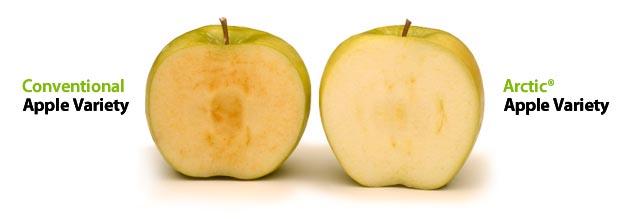
Arctic® apples vs regular apples.
These fancy new apples are being sold sliced and packaged in plastics, because apparently humanity generates too little plastic waste from packaging, and we must try as hard as we can to make even more. Just how lazy a person has to be in order to be unable to slice their own apples before eating them?
The fact that apples become brownish after being sliced is not a problem. Instead the problem is that many consumers have ridiculous ideas about how fruits and vegetables are supposed to look like.
For example, here is an online article titled “Supermarket Buying Guide: How to Buy Produce.” Here’s a quote from it.
Vegetables should look fresh, with no bruises or punctures; leafy vegetables should be free of insect damage, root vegetables not shriveled or decayed…Don’t buy damaged fruits or vegetables even if they’re a bargain—they’ll be less nutritious (and less tasty) than fresh.
This is terrible advice that is bound to increase food waste. Bruises or punctures are no big deal if you are planning to eat some fruit or vegetable immediately after purchasing it. They become a problem only if you are planning to store said food for a week before eating it, because bruises and punctures speed up rotting. As for insect damage, I grow some of my own food, and over my lifetime I have eaten a lot of vegetables with some minor visible insect damage. Sure, there are cases when insect damage on fruits and vegetables is so terrible that the food becomes inedible, but some minor visual defects are no big deal. Various critters live in gardens, and they are interested in snacking on the food humans produce. Deal with it. Moreover, of course, you should avoid fruits and vegetables that are decayed and rotten, but “fresh” is more complicated. For example, it is currently spring, the carrots I now eat were harvested half a year ago. They are no longer as crunchy and juicy as they used to be in autumn. The taste really is worse when eating such carrots raw, but when cooked they taste pretty much the same as fresh carrots.

“Ugly” fruits and vegetables that are perfectly fine to eat.
I don’t particularly complain about other customers rejecting “ugly” fruits and vegetables whenever their silly behavior allows me to get cheaper food. For example, two weeks ago I bought some cauliflower with minor visual defects that was 60% cheaper than normally.
But I do complain when other consumers’ decisions result in me becoming unable to get tasty fruits and vegetables. Let’s get back to apples.
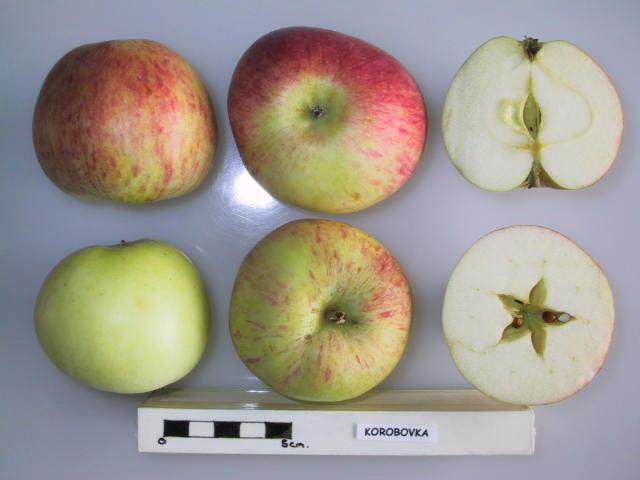
Apple cultivar “Korobovka.”
Shown here is my favorite apple cultivar, “Cukuriņš” in Latvian or “Korobovka” in Russian, it is an old (from 1800ties) apple cultivar that originates from Russia. The apples are small, but have a very sweet taste. They ripen early in summer, and the tree is very winter-hardy.
I can get these apples only in farmers’ markets, because all supermarkets have collectively decided that these apples are too tiny and too ugly to sell. Yes, they are tiny and not particularly pretty, but so what. Who cares! I buy apples in order to eat them, I don’t buy them to stare at them. These apples are tasty, and that’s what matters for me.
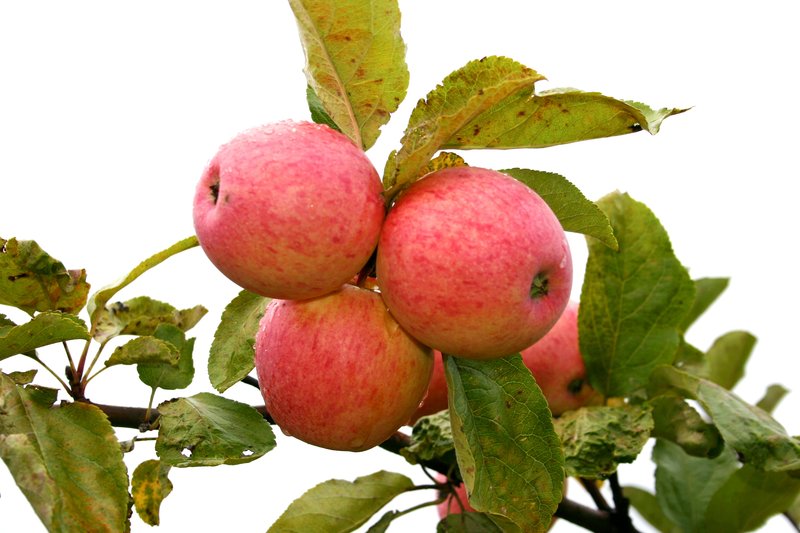
Apple cultivar “Tiina.”
My second favorite apple cultivar is “Tiina,” which was created in Estonia and registered as a new cultivar in 2001. These apples ripen in autumn, and they are also very sweet and juicy. These apples are larger and prettier than “Korobovka,” but supermarkets still won’t sell them, because they aren’t large and pretty enough.
Instead, supermarkets sell apples that are large, pretty, and have a very long shelf life. Unfortunately, they also taste like cardboard. If not for the local farmers’ market, it would be impossible for me to buy apples, because the pretty and supposedly fancy crap that is sold in supermarkets isn’t tasty enough to be edible.
This problem isn’t happening only with apples, this is happening with all the fruits and berries out there, because large retail chains demand cultivars that produce pretty fruits with a long shelf life. They don’t give a damn about how these fruits taste.
I find it absolutely amazing that scientists are now able to genetically modify plants. That’s really cool. Genetically modified papaya plants that are resistant to the papaya ringspot virus are amazing. That’s an example of how this technology ought to be used. Hawaiian papaya production was almost destroyed by this virus. Transgenic papaya varieties that are resistant to PRSV entered production in 1998 and resuscitated the industry. Golden rice is also great. While I do think that the long term solution for a nutrient deficiency and malnutrition would be diversifying and improving poor people’s diets, a quick fix that can immediately improve people’s lives and alleviate suffering is still very welcome.
But nonbrowning apples! Come on, this is ridiculous. Are you seriously trying to tell me that one of the greatest problems with our food supply is the fact that apples become brownish a while after slicing?
I have a better proposal. I want genetically modified grapes, apricots, peaches, nectarines, and kiwifruit that are winterhardy enough to endure cold Latvian winters.
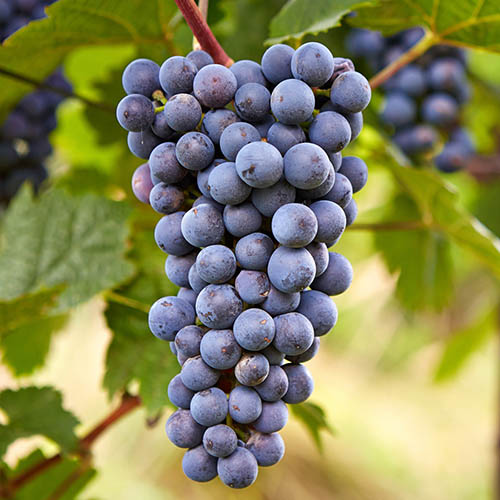
Grape cultivar “Zilga.”
It is already possible to grow grapes in Latvia. Pictured here is the grape cultivar “Zilga,” which I am already growing. The vine is extremely frost resistant to minus 40° Celsius. The pesky drawback—berries are small (1.7 grams), and the average weight of a cluster is also small (88 grams), also the taste isn’t really that good either. I do perceive these grapes as tasty enough to eat them, but they are a bit sour and nowhere near as tasty as grapes that are grown in warmer climates.
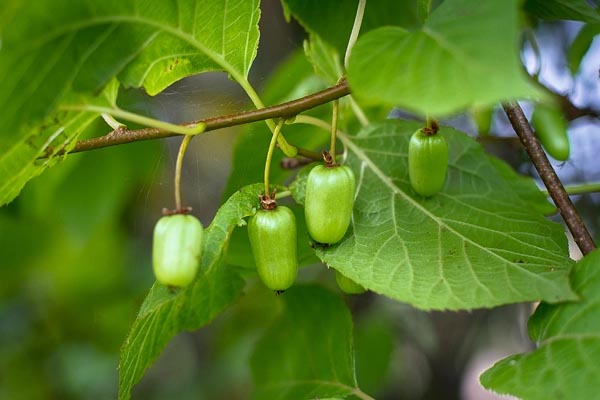
Actinidia kolomikta fruits.
On my boyfriend’s land (which I have appropriated for my food production needs), I also grow Actinidia kolomikta. This plant produces small edible berries, which taste somewhat like kiwifruit. And, yes, this plant is closely related to what consumers call kiwifruits, the difference is that these plants are more winterhardy and have tiny fruit.
In Latvia, it is also possible to grow apricots, cultivars like “Velta,” “Lāsma,” etc. In Latvia, growing apricots on apricot rootstock is impossible, because the resulting plants would freeze to death in winters. Thus here growers graft apricots on plum rootstock. The problem is limited compatibility between plum rootstock and apricots. Prunus cerasifera var. divaricata is the most commonly used rootstock, because they grow quickly and make strong roots. Yet these plums are not fully compatible with apricots, thus resulting trees often die after a while. Personally, I am currently experimenting with grafting apricots on a plum cultivar “Latvijas dzeltenā olplūme.” When fruit trees get hurt in too cold winters, the trunk is the first part that dies. Branches that are higher above the ground survive better. This is why in Latvia gardeners who are willing to spend a lot of time fussing with a single fruit tree often plant a winterhardy cultivar and then graft another cultivar with better fruit quality on each of the branches higher above the ground. For now, I am still waiting for my plum tree to grow larger so that I can try to turn each of its branches into apricots.
As for peaches and nectarines, nobody in Latvia is even trying to grow those outside of greenhouses; they simply aren’t even remotely winterhardy enough for this climate. So yeah, I really want genetically modified warmer climate plants that are made more winterhardy. But no, instead scientists are working on some silly nonbrowning apples that could be sold already sliced and wrapped up in plastic.
But fine, let’s put aside silly nonbrowning apples for a moment. What humans are doing with our food supply is plain terrifying. Gene patents must be outlawed. Corporations that exploit their monopoly position and have way too many lawyers on their payroll must be reined in (hint: I’m talking about Monsanto). State governments must pay for creating new plant cultivars. This is serious. We are talking about humanity’s food supply, something that is essential for our survival. We cannot afford to let for-profit corporations to promise that they will make new and better plant cultivars for us. Yes, so far in wealthy countries the food supply is secure. But the key words are “so far.” The climate is changing. We will need new and improved plants that can adapt to too much or too little water combined with the wrong temperature, never mind pests and diseases. If we want to avoid mass famines (I strongly suspect that there will be plenty of them once the climate becomes shitty), we should start working on new plant cultivars while we still have time to plan ahead.
I am disappointed with how corporate interests have turned the term “GMO” into something people hate. Sure, gene patents and nasty business practices are, well, nasty. But the technology itself would have so much potential.
I am even more disappointed with the organic farming industry. Their business model is based upon lies and fearmongering. “Natural=good; chemical=bad” is a ridiculous idea to promote. It’s also harmful and spreads mistrust towards science among uneducated people who easily fall victims to fearmongering. Lifesaving medicines are “chemicals.” Toxic mushrooms are “100% natural and organic.” Whether some molecule can be found in the nature or was synthesized in a lab is not how you determine whether you should get it into your body.
Sure, I am aware that conventional agriculture kills bees, depletes phosphorus reserves (phosphate rock being a finite natural resource), and fucks up soil. We do need to change agricultural practices towards something more sustainable, so that we can produce safe food for all the humans on this planet in a way that harms the environment as little as possible.
Yet the organic farming standards were never meant as a rational, evidence-based, and scientific attempt to establish optimal guidelines for how to achieve these goals. Instead it was the result of an infantile black versus white mindset that categorizes everything natural as good and everything created in a laboratory as toxic. Various technologies have both benefits and drawbacks. For example, using synthetic fertilizer increases crop yields (thus humans need a smaller amount of agricultural land in order to get the same amount of food) but also uses up finite natural resources and harms rivers due to fertilizer runoff. A rational and evidence-based approach would compare such benefits and drawbacks and calculate exactly how much (if any) synthetic fertilizer farmers should use for the best possible results. By the way, modern synthetic fertilizers can provide numerous different nutrients for plants (nitrogen, phosphorus, potassium, calcium, magnesium, copper, iron, manganese, etc.), thus it is possible that maybe in some circumstances farmers should provide only some of these nutrients from a synthetic fertiliser and not not the others.
Determining optimal methods how to produce food would require plenty of work from scientists with degrees in agriculture who are also capable of advanced statistical analysis. Moreover, it would be impossible to create a single set of rules that are applicable for all the plants out there. Some plants need little fertilizer and are naturally resistant to pests and diseases. For such plants it would make sense not to use synthetic fertilizers and pesticides. But for other plants using modern technologies significantly improve yields. It depends. Agriculture is complicated. Various technologies have both benefit and drawbacks.
Unfortunately, guidelines for organic farming are simply a list that bans everything “non natural” and “chemical” that some uneducated victim of fearmongering might possibly dislike.
Let’s consider pesticides, for example. Ask people who buy organic food what they like about it, and most will say “they’re grown without pesticides.” Yet that’s not even factually true. In organic farming only synthetic pesticides are prohibited. A chemical is said to be synthetic if it does not already exist in the natural world. As long as some substance is naturally occurring somewhere on this planet, farmers can use it as a pesticide. Organic farmers do use pesticides. A lot of them. And no, the mere fact that some molecule occurs somewhere in the nature doesn’t mean that said substance is better or safer when used as a pesticide. For example, Rotenone is worth looking at more closely. Despite the high toxicity of Rotenone to aquatic life and some links to Parkinson disease, it is still allowed in organic farming as it is a naturally occurring compound (it occurs naturally in the seeds and stems of several plants).
Alternatively, the toxin produced by Bacillus thuringiensis (Bt) has been used as an insecticide spray since the 1920ties and is commonly used in organic farming. Bt proteins are allowed in organic farming as an insecticide, because Bt is a bacterium that is found naturally in the soil. Bt is also the source of the genes used to genetically modify a number of food crops so that they produce the toxin on their own to deter various insect pests. Using Bt as an insecticide is allowed in organic farming, but growing plants that have been genetically modified to produce the same substance is somehow evil. That’s irrational.
And the most terrible part is that a lot of things that are happening with our food supply are irrational. From silly nonbrowning apples, to consumers imagining that fruit and vegetables with minor visual defects are inedible, to gene patents, to organic farming standards.
Speaking of the latter, marketing specialists who promote organically grown food have spent decades telling consumers that chemicals are bad and that scientists cannot be trusted. I wonder how many people started with organic food (due to being afraid that they might ingest chemicals) only to fall deeper in the pit of fear thus ending up as anti-vaxxers and fans of alternative medicine in the form of various natural food supplements that are supposed to cure all illnesses. Misinformation drives fear and ignorance. Humanity is approaching the point when we will need all the technologies we have just to avoid mass famines, yet numerous people are afraid that technology creates food that contains toxins and is harmful for health. This sounds like a recipe for a disaster to me.

When I saw your title I thought it would be about making cider! For me, if an apple is “too ugly to eat” you make cider out ot if. But to go along with your topic, when you do make cider, one thing you do is put the apples in a cool dry place and just let them sit there for several weeks until they become soft. This process is called sweating, and makes the apples soft enough to be chopped up for the press. A lot of people are terrified of this and won’t do it; they think the apples have gone “bad”. I have a cider press and every year the neighborhood comes to my house and we chop and press everybody’s apples for them. And every year, despite my explaining the process carefully, people bring apples that have not been sweated, and they are so hard they can’t be chopped. We have to stop and cut such apples into tiny little pieces by hand, as opposed to just throwing them in the chopper (it’s an electrical chopper). So I see in my own life this fear of things being “old” or “bad”. People have a terrible fear of this, they also really fear bacteria, even though bacteria are necessary to life. I’ve taught some people to make cheese and they are astonished that I deliberately put bacteria in milk, and not only that, I let that milk sit outside the refrigerator for **days**! Whereas, to me, what is truly scary is an apple where you can’t tell how old it is. And milk that has been so pasteurized (super pasteurized, flash pasteurized) that it will not form a curd.
Kestrel I think the reason that many milks will not form curds is that they have been homogenised, ie the fat and protein globules that would agglomerate to make curd have been broken up into smaller particles in the whey of the milk rather than anything to do with the pasteurisation process. But it is annoying, I can still make paneer, but I have to use far more acid to get the milk to curdle, even then it doesn’t take as much fat and proein out of the emulsion,
I do get very frustrated by the conflation by so many people of the problems of corporatisation and the techniques of genetically altering the plants we use for food or materials. There are valid reasons to be concerned about the immense power that the few corporations involved in our food supply have, but as you say Andreas the tehniques involved in producing GMOs are not in themselves ‘evil’ and cn be very helpful.
kestrel @#1
For me there are no fruits too ugly to eat. As long as they taste good, I’ll eat them.
Of course, making something else from these fruit is another option.
Here yoghurt is commonly advertised as containing live bacteria. I think that most people in Latvia know that various dairy products are made with bacteria.
Yeah, I agree, besides such apples usually taste like cardboard.
When it comes to milk processing, pasteurization and homogenization are separate actions.
I mostly drink non-pasteurized and non-homogenized whole milk (about 4.0 to 4.2% fat). In Latvia raw milk is commonly sold in grocery stores and farmers’ markets. Selling raw milk is legal and tightly controlled by the government, so it is safe to drink raw milk here. I wouldn’t mind the pasteurization, but I do dislike how homogenization changes the taste of milk. I also dislike that processed milk almost always contains less fat. (Skim milk is a rip-off—I pay money for food, but get fewer calories for the same price; moreover, the taste is also inferior.)
Also, when fresh milk gets sour, it remains edible. Elderly people in Latvia consider sour milk a drink, but personally I do dislike the taste of sour milk. However, sour milk is perfect for cooking pancakes. Thus I never have to throw out any milk even if it gets sour. When processed milk gets sour, it’s different from sour raw milk and cannot be used for any recipes.
That being said, I have nothing against ultra-pasteurization (UHT). There’s nothing inherently harmful about the process and it immensely prolongs the shelf life of milk. The milk is simply heated to a high temperature for a few seconds. Sure, the taste is different, and I do prefer the taste of fresh milk, but it’s not that terrible. All the goat milk I and my puppies drink is UHT.
Jazzlet @#2
Yep. The overwhelming majority of food found in American grocery stores is sold by only a couple of huge corporations. That’s a problem. Yet people fail to notice or care about this. Simultaneously, the same people are worried about Monsanto, because OMFG GMOs. Corporate control of the food supply is a problem regardless of what technology some corporation uses or doesn’t use.
Minor nit to pick: several years ago Monsanto was bought out by Bayer, the German company that makes the popular (in the U.S.) brand of aspirin. It turned out to be not a really good investment for them since they now have a bunch of class action lawsuits pending. I can’t remember the details.
(FWIW, I grew up just a hop, skip and a jump from the Monsanto headquarters in Creve Coeur, Missouri, USA.)
Hey, that’s me!
… oh.
More seriously, I think this is an excellent introduction to a complicated and important topic. Thank you for educating the public.
lumipuna @#6
You have studied agriculture? That’s cool. I never got any formal education about this topic, but I do read textbooks about agriculture. I perceive it as really fascinating. I have been mostly interested in how new fruit tree cultivars are made. Just for fun. In practice, I only grow a few edible plants.
I find it frustrating that many people who are worried about the environment or about the safety of the food supply do more harm than good, because they are incapable of evaluating the benefits versus drawbacks of some technology. “If we do X, does the benefits outweigh the problems?” is a question that ought to be answered by looking at statistics. But no, many people want whatever looks “greener” on the surface. Thus we got first-generation biofuels, single-use paper shopping bags, and Latvia’s utterly terrible deposit system for PET soft drink bottles.
Right now in Latvia we have environmental activists who fight against non-organic cotton and wind power plants. The same people seem to not give a shit about the fact that coal is still being burned in Latvia for energy.
I have a master’s in horticultural science, and now I’m struggling with PhD studies in same field, still with an embarrassingly basic knowledge of statistical analysis.
I agree that environmentalism has deep problems between corporate greenwashing and irrational consumer nostalgia for low-tech solutions. My studies broached these issues (agroecology) as well as plant breeding and plant biotechnology.
As for apples, I feel the tiny ones are extremely handy for snacking several times a day. Traditionally, only a few apple cultivars are grown commercially here in Finland, and these winter-hardy cultivars all have fairly small fruits. These are commonly sold in supermarkets, not that they’re very good (IMO) but people value them out of sheer tradition, harking back to the time before foreign fruit imports. There’s generally strong consumer support for local produce in Finland. In imported apples, large size is preferred and generally taken for granted.
Fairly recently several new cultivars have been introduced in Finnish production, with varying fruit sizes. Two of these, Rubin and Rubinola, are are actually really good and they also store relatively well. I’m just now eating the very last ones I hoarded from this winter’s sale.
lumipuna @#8
Speaking of plant breading, I suspect that chemical-phobes who want all-natural food would freak out if they had any idea how plant cultivars are made. For example, self-fertile cherry cultivars (like “Lapins” and “Stella”) were created by inducing mutations with radiation.
By the way, in Latvia we still don’t have any commercially viable self-fertile sweet cherry cultivars (there are only self-fertile sour cherries). There have been breeding programs that crossed self-fertile sweet cherry cultivars (all of which aren’t sufficiently winterhardy) with local winterhardy cherry cultivars, but so far there are no results.
Yep, I agree.
“Rubinola” apple cultivar isn’t grown here, I don’t think I have ever tasted it. At least I have no memories about trying it.
In Latvia there are two apple cultivars with the name “Rubin.” One is a winter variety originating from Czechia and is grown in European countries with warmer climate than Latvia, up to Lithuania. The other comes from Kazakhstan, ripens in autumn and is grown in commercial orchards of Latvia.
Since you are talking about Finland, I assume you meant the more winterhardy “Rubin” cultivar.
“Rubin” grows well in Latvia, but here it isn’t considered an exceptionally winterhardy apple cultivar. Personally, I graft my apples on “Antonovka” trunks. I like growing lots of different apple cultivars, but I am not going to have a dozen apple trees in my garden. Thus I graft at least 3 or 4 different cultivars on a single apple tree. Here “Antonovka” is considered as one of the most winterhardy apple cultivars, but their apples are also tasty. A bit sour, but I like them.
Then again, winterhardiness problems in Finland could differ from what we have here. I actually have no clue about the climate in Finland. In Latvia plant cultivars must have a long dormancy period in order to qualify as sufficiently winterhardy. Here winters have fluctuating temperatures. Often you have a cold week, then soon after all the snow melts only for the weather to get cold again a few weeks later. Thus -30°C in December won’t kill any of the plants that are grown here. Instead, the real danger is getting -20°C in February. After a long and warm autumn/early winter, plants already start preparing for the spring and lose their cold tolerance. And that’s when they die. For example, many apricot cultivars are considered winterhardy in Russia where winters are cold but the temperature doesn’t fluctuate that much. In Latvia the same apricot cultivars just freeze to death in spring, because their natural dormancy period isn’t long enough.
I think the climate here in southernmost Finland (where our fruit production is concentrated) is very similar to Latvia. And indeed, winter hardiness depends on many factors: How long growth season does it take for buds to mature, how easily the plant hardens for cold and how much, and how easily the dormancy breaks.
I see a gradual “encroachment” of warm temperate crops into more northern areas. This is partly related to climate change, but also developments in plant breeding and cultivation technique. Our domestic apple production is growing, pear and plum have been recently established as commercial crops, there’s experimentation with sweet cherry and grape.
There are folks who won’t eat broccoli, even though it’s tasty and nutritious. In a free society where people can be the gender they are and have consensual sex with who they please, nobody thinks much of this. Except maybe their mothers, trying to get children to eat their vegetables.
GMOs may be utterly harmless. But it doesn’t matter, because free people can eat what food they like, if they can get food. It is not a necessary supposition for Greens or agribusiness to interfere one way or another.
seachange @#11
I never argued that people cannot be allowed to choose what they want to eat. Instead I argued in this blog post that it is wrong for marketing people to spread lies and engage in misleading fearmongering. Or are you one of those people who imagine that free speech must be absolute and that everybody should have a right to tell any lies they like? For example, if science has proven beyond any reasonable doubt that some technology is safe, do you still want to insist that people have a right to spread lies about how this technology is harmful, because it introduces chemicals in our food supply?
You ought to realize that telling lies to the public results in harmful consequences.
@ ^ Andreas Avester : Truth!
Exhibit A : the current COVID 19 Pandemic where Trump’s lies and misinformation have already literally killed people.
Exhibit B : Global Overheating (“Warming” is too misleadingly mild a word) where likewise decades of Climate Denialism has led to government inaction for decades with irreversible and catastrophic consequences and implications that we’re already seeing and will for the rest of our lives and (if you have them) our children’s lives and their children indefinitley into the future.
Exhibit C : Anti-vaxxer propaganda that has led to a resurgence in old diseases claiming people’s lives needlessly and making the world we all collectively share and live in so much less safe and worse for everyone.
Plenty of other examples could be added of course..
Personally, I’d like the deliberate spread of known dangerous falsehoods to be made a crime – at least for politicians and those in the media who are – often wrongly, & sometimes with fatal results – trusted sources of many people.
Thinking of, I guess you’ve already heard of this :
https://theintercept.com/2020/03/24/trump-hyped-chloroquine-cure-covid-19-man-arizona-took-died/
Wrapping fruit in platic or putting stickers on it has been a major pet hate of mine for ages. So unnecessarily wasteful.
As for apple varieties do you get and have youe ver tried Royal Galas? Seems to me like they could be the Aussie equivalent of your Tiina cultivar maybe?
StevoR @#14
It is impossible to grow “Royal Gala” in Latvia, because this cultivar isn’t sufficiently winterhardy for this climate. Apple trees would freeze to death in Latvian winters.
I have tried “Royal Gala,” I have bought these apples while staying in Germany. They were OK. And no, they didn’t taste the same as my favorite Latvian apple cultivars. Even though all of these apple cultivars are sweet, there are some differences in taste.